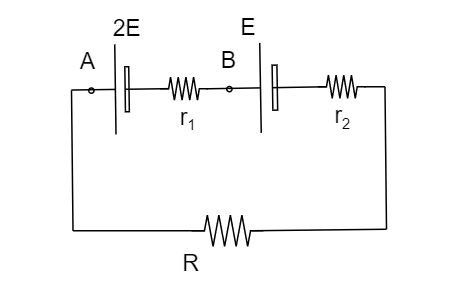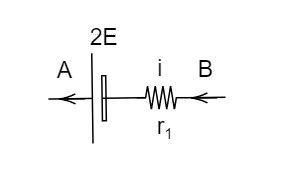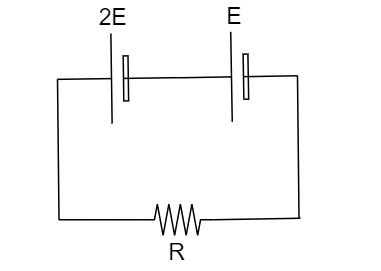
Answer
99.9k+ views
Hint: Before we proceed into the problem, it is important to know the definition of potential difference and internal resistance. Potential difference is defined as the difference of the electrical potential between the two points. The internal resistance opposes the flow of current offered by the cells and batteries themselves resulting in the generation of heat.
Formula Used:
\[i = \dfrac{{3E}}{{R + {r_1} + {r_2}}}\]
Where, E is the emf of the cell, R is the external resistor, $r_1$ and $r_2$ are the internal resistances of the cells.
Complete step by step solution:
Now let us solve the problem step by step considering the definition.

Image: Two cells connected in series with the resistor R.

Image: The potential difference across the terminals of the first cell.
By applying the KVL for the given circuit we get,
\[ + 2E - iR - i{r_2} + E - i{r_1} = 0\]
\[\Rightarrow 3E = i({r_1} + {r_2} + R)\]
\[ \Rightarrow i = \dfrac{{3E}}{{R + {r_1} + {r_2}}}\]…….. (1)
In order to find the R value, they have given that the potential difference between point A and B is zero i.e.,
By the circuit we can write the potential difference between the point A and B as,
\[{V_A} - 2E + i{r_1} - {V_B} = 0\]
\[\Rightarrow {V_A} - {V_B} = 2E - i{r_1}\]
\[ \Rightarrow 2E = i{r_1}\]……. (2) Since \[{V_A} - {V_B} = 0\]
Now substituting equation (1) in (2) we get,
\[2E = \dfrac{{3E}}{{R + {r_1} + {r_2}}} \times {r_1}\]
\[\Rightarrow 2R + 2{r_1} + 2{r_2} = 3{r_1}\]
\[\Rightarrow R = \dfrac{{{r_1}}}{2} - {r_2}\]
Therefore, the value of \[R = \dfrac{{{r_1}}}{2} - {r_2}\]
Hence, Option D is the correct answer.
Note: Suppose if two or more cells are connected in parallel having the same emf, then the resultant emf will be equal to the emf of any one of the cells. If the cells are of different emfs, then the resultant emf will be equal to the emf of the cell which is having the greater value of emf.
Formula Used:
\[i = \dfrac{{3E}}{{R + {r_1} + {r_2}}}\]
Where, E is the emf of the cell, R is the external resistor, $r_1$ and $r_2$ are the internal resistances of the cells.
Complete step by step solution:
Now let us solve the problem step by step considering the definition.

Image: Two cells connected in series with the resistor R.

Image: The potential difference across the terminals of the first cell.
By applying the KVL for the given circuit we get,
\[ + 2E - iR - i{r_2} + E - i{r_1} = 0\]
\[\Rightarrow 3E = i({r_1} + {r_2} + R)\]
\[ \Rightarrow i = \dfrac{{3E}}{{R + {r_1} + {r_2}}}\]…….. (1)
In order to find the R value, they have given that the potential difference between point A and B is zero i.e.,
By the circuit we can write the potential difference between the point A and B as,
\[{V_A} - 2E + i{r_1} - {V_B} = 0\]
\[\Rightarrow {V_A} - {V_B} = 2E - i{r_1}\]
\[ \Rightarrow 2E = i{r_1}\]……. (2) Since \[{V_A} - {V_B} = 0\]
Now substituting equation (1) in (2) we get,
\[2E = \dfrac{{3E}}{{R + {r_1} + {r_2}}} \times {r_1}\]
\[\Rightarrow 2R + 2{r_1} + 2{r_2} = 3{r_1}\]
\[\Rightarrow R = \dfrac{{{r_1}}}{2} - {r_2}\]
Therefore, the value of \[R = \dfrac{{{r_1}}}{2} - {r_2}\]
Hence, Option D is the correct answer.
Note: Suppose if two or more cells are connected in parallel having the same emf, then the resultant emf will be equal to the emf of any one of the cells. If the cells are of different emfs, then the resultant emf will be equal to the emf of the cell which is having the greater value of emf.
Recently Updated Pages
Write a composition in approximately 450 500 words class 10 english JEE_Main

Arrange the sentences P Q R between S1 and S5 such class 10 english JEE_Main

Write an article on the need and importance of sports class 10 english JEE_Main

Name the scale on which the destructive energy of an class 11 physics JEE_Main

Choose the exact meaning of the given idiomphrase The class 9 english JEE_Main

Choose the one which best expresses the meaning of class 9 english JEE_Main

Other Pages
A series RLC circuit consists of an 8Omega resistor class 12 physics JEE_Main

The shape of XeF5 + ion is A Pentagonal B Octahedral class 11 chemistry JEE_Main

A block A slides over another block B which is placed class 11 physics JEE_Main

If a wire of resistance R is stretched to double of class 12 physics JEE_Main

Two billiard balls of the same size and mass are in class 11 physics JEE_Main

A tetracyanomethane B carbon dioxide C benzene and class 11 chemistry JEE_Main





